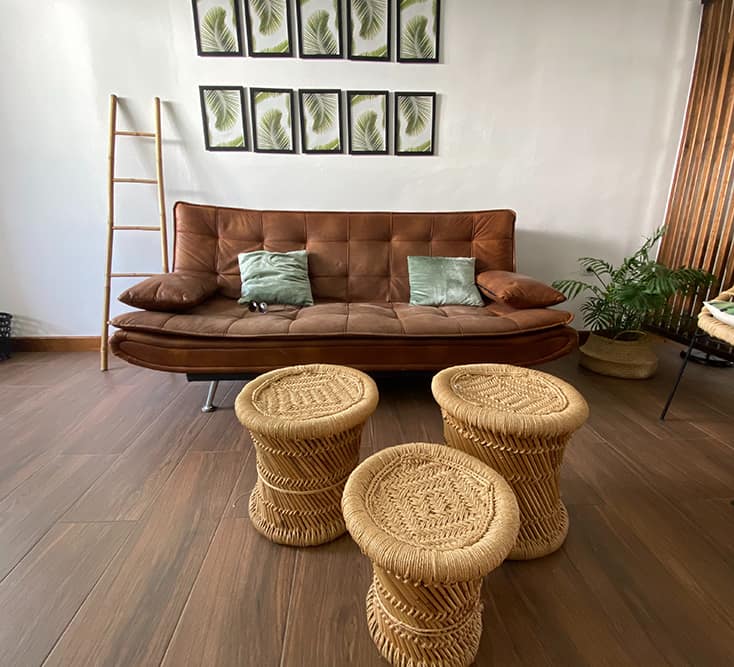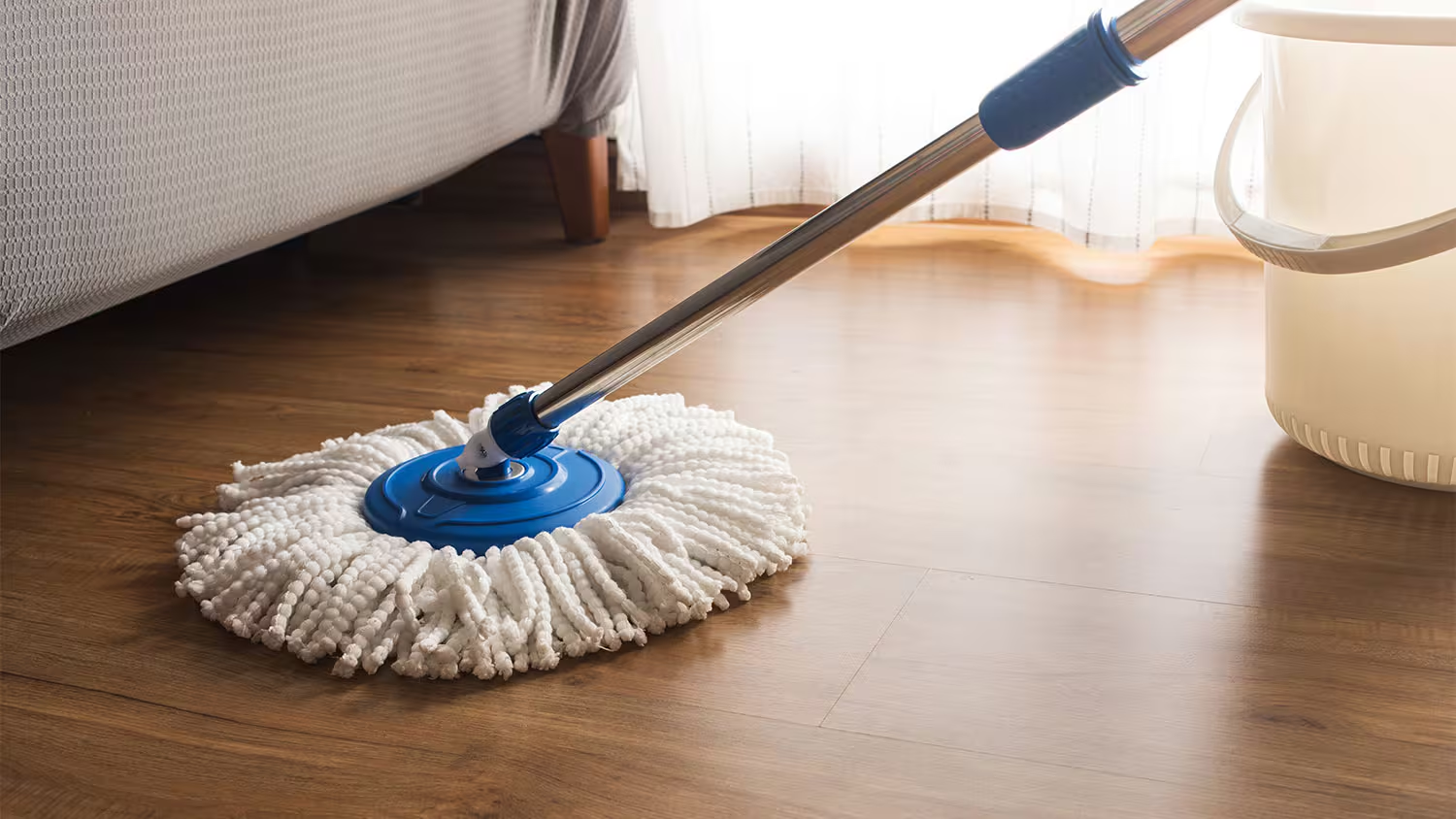Choosing the right flooring can be tricky, especially for areas like bathrooms, kitchens, or basements where moisture is a concern.
The wrong choice could mean warping, water damage, or constant upkeep – not exactly what you want in a busy home.
Vinyl plank flooring steps in as a budget-friendly, durable option that looks like wood or stone, with the added bonus of being waterproof. It’s worth considering if you’re looking for a floor that can handle spills and splashes without hassle.
This guide will help you understand how vinyl’s waterproofing works, where it’s best used, and what to keep in mind before you choose a flooring option.
Is vinyl flooring waterproof?
Yes, home vinyl flooring is waterproof because it’s made from synthetic materials like PVC that do not absorb water. Its multi-layered construction, including a protective wear layer and a waterproof core, helps prevent moisture from penetrating the surface.
While this material can handle spills, humidity, and everyday moisture, it’s important to clean up standing water quickly to avoid potential damage to the subfloor.
What Does “Waterproof” Mean for Vinyl Plank Flooring?
When it comes to flooring, understanding the difference between “water-resistant” and “waterproof” is key. Water-resistant vinyl can repel moisture to a certain extent, making it suitable for areas with occasional spills or light humidity.
However, if water is left standing for a prolonged period, it can seep through seams or cause damage.
On the other hand, fully waterproof vinyl planks are designed to prevent water from penetrating the surface altogether. It features a construction that blocks moisture from affecting the flooring material itself, even if water sits on the surface for a while. This makes waterproof vinyl a better choice for rooms where frequent exposure to moisture is expected, such as bathrooms and laundry rooms.
Why Might You Need Waterproof Flooring In Your Home
Vinyl plank flooring’s waterproof qualities shine in everyday situations. For instance, in kitchens where cooking spills and water splashes are common, vinyl flooring resists stains and moisture damage.
In homes with pets, it can handle accidents without warping or staining, as long as they are cleaned up promptly. Bathrooms are another area where vinyl flooring excels, providing a durable and slip-resistant surface that holds up against humidity and steam from showers.
Basements, prone to moisture due to their below-grade location, also benefit from the material’s waterproof nature, helping protect against potential dampness.
While vinyl can manage typical household spills and humidity, it’s important to avoid long-standing water that could compromise the subfloor over time.
How Vinyl Plank Flooring Is Made to Be Waterproof
Vinyl flooring is waterproof due to its materials and multi-layered construction. Made from PVC, a water-resistant synthetic plastic, it is designed to keep moisture out and maintain its shape. Here’s how it achieves its waterproof qualities:
Multi-Layered Structure
The flooring consists of multiple layers:
- Wear Layer: A protective top layer that resists water, scratches, and stains.
- Image Layer: Mimics the look of wood, stone, or other materials while being moisture-resistant.
- Rigid Core (WPC or SPC): Provides full waterproofing. WPC (wood-plastic composite) has a softer feel, while SPC (stone-plastic composite) is denser and better for impact resistance.

Multiple Installation Options
The way vinyl plank flooring is installed can also affect its waterproofing capabilities. There are several installation methods, each with its own benefits:
Glue-Down Installation
Planks are adhered directly to the subfloor, creating a tight bond that minimizes gaps where water could seep through. This method is effective for high-moisture areas but requires proper subfloor preparation.
Floating Floors (Click-Lock Systems)
These planks snap together to form a “floating” floor over the subfloor. While this method is DIY-friendly and doesn’t require glue, water can still seep through if the joints are not tightly locked or if the installation is not done correctly.
Peel-and-Stick Installation
This method involves adhesive-backed vinyl planks that stick directly to the subfloor. Though convenient, it may not provide the same level of waterproofing as click-lock or glue-down methods, especially if the adhesive weakens over time.
Proper installation, regardless of the method, is crucial for maximizing the waterproof benefits of vinyl plank flooring. Ensuring a level, dry subfloor and following manufacturer guidelines can help maintain the floor’s waterproof integrity and prolong its lifespan.
Types of Vinyl Plank Flooring and Their Waterproofing Capabilities
Vinyl plank flooring comes in different types, each with unique waterproofing capabilities suited for various needs and environments. Here’s a closer look:
Sheet Vinyl vs. Plank Vinyl For Waterproofing
Sheet Vinyl comes in large, continuous sheets, which means there are fewer seams where water can seep through. This makes sheet vinyl more water-resistant than plank options, especially when installed in a single piece. It’s often used in bathrooms, laundry rooms, and other spaces where moisture is common.
Plank Vinyl is composed of individual planks that lock together or are glued down. While each plank is waterproof, the seams between planks can allow water to penetrate if not properly installed or sealed, making installation quality crucial for maximum water resistance.
Hybrid Floors
Hybrid flooring combines the best features of vinyl and other materials (like laminate) for added resilience in wet areas. These floors often have a rigid waterproof core similar to SPC, along with enhanced wear layers that make them suitable for areas with frequent moisture exposure, such as bathrooms, kitchens, and laundry rooms.
Hybrid floors provide a blend of comfort, durability, and water resistance.
Each type of vinyl plank flooring has distinct advantages depending on the area where it will be installed, and understanding their waterproofing capabilities helps in choosing the best option for specific needs.
How To Maintain Vinyl Plank Flooring in Wet Areas
Keeping vinyl plank flooring in good shape in wet areas requires proper cleaning and preventive measures. Here’s how to maintain your floors to ensure they stay waterproof and durable:
Cleaning Tips
Regular cleaning is crucial to preserve the waterproof qualities of vinyl plank flooring. Routine sweeping or vacuuming helps remove dirt and debris that can scratch the surface.
For deeper cleaning, use a damp mop with a mild floor cleaner, which will keep your surfaces looking fresh without compromising its water-resistant properties. It’s important to choose cleaning products specifically designed for vinyl to avoid damage.
While vinyl flooring is waterproof, steam mops should be avoided, as the high heat and moisture can weaken adhesives or damage the protective wear layer over time. Stick to traditional mops and avoid harsh chemicals, abrasive scrubbers, or wax-based products, which can wear down the floor’s protective coating and diminish its water resistance.

Preventing Water Damage
To ensure vinyl plank flooring remains fully waterproof, it’s important to prevent standing water and quickly address any spills. Wipe up any moisture as soon as it appears to avoid water seeping into the seams or reaching the subfloor. While vinyl itself is waterproof, standing water can still find its way into cracks if left unattended.
Using absorbent mats or rugs near entryways, sinks, and tubs is a good practice, as it helps catch drips and splashes, particularly in high-traffic areas.
Additionally, for rooms like bathrooms and laundry rooms that experience frequent moisture, sealing the perimeter edges with waterproof caulk can prevent water from leaking underneath the flooring. In kitchens, adding a waterproof underlayment provides an extra layer of protection.
Finally, conducting regular inspections of the flooring can help identify early signs of damage, such as lifting seams or loose planks. Addressing these issues immediately prevents water infiltration and ensures your vinyl plank flooring remains in optimal condition.






